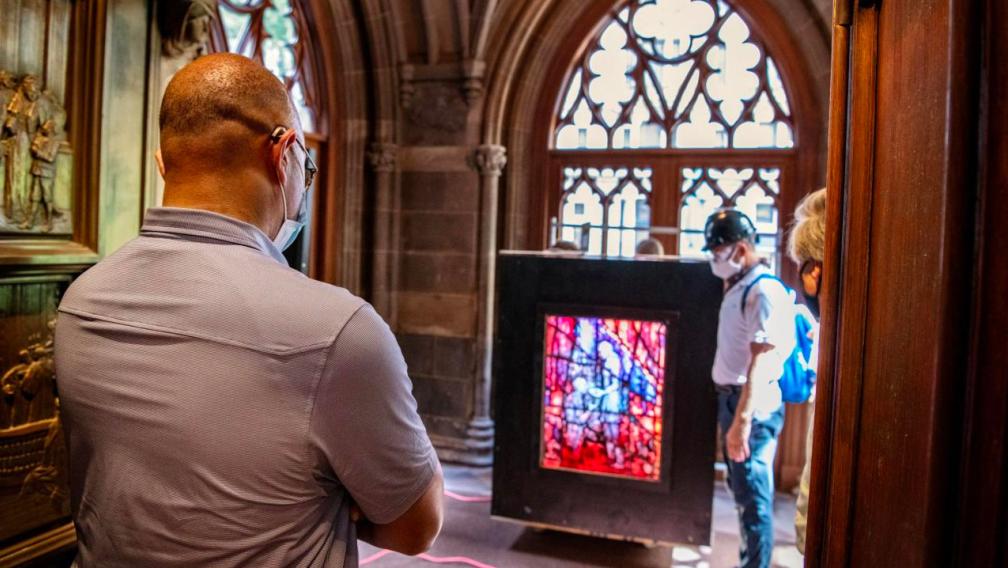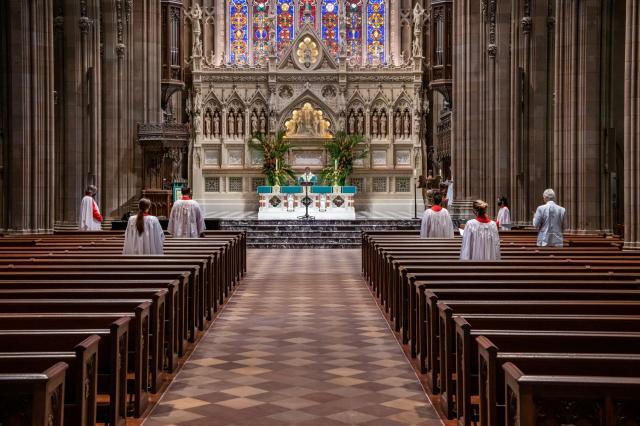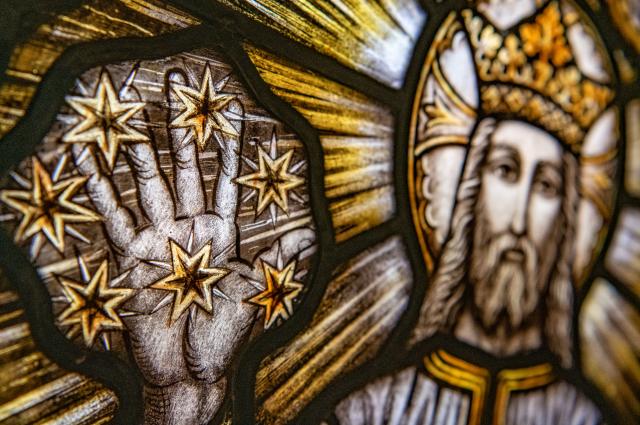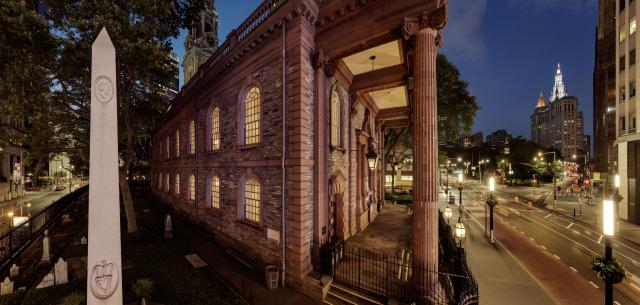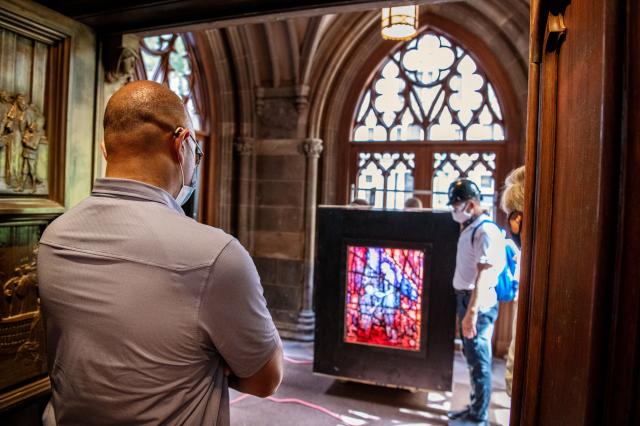Trinity Church Wall Street began rejuvenation of the nave of its 1846 church building in May 2018. The first major upgrade of Trinity’s interior space in 75 years proceeded for 19 months, until Christmas Eve 2019 when public worship resumed.
Additional rejuvenation, especially in the Chapel of All Saints and on Trinity’s exterior, continued into the new year until March and the onset of the novel coronavirus (COVID-19) pandemic. Rejuvenation halted for three months.
Construction in New York City resumed June 8 with Phase 1 of re-opening. Photographer Colin Winterbottom, who has documented the rejuvenation since its beginning, offers his latest images which reflect the very unusual circumstances caused by the pandemic.
“Having been away for four months it was striking to see the space again,” Winterbottom said. “I documented every stage of the nave’s transformation yet seeing it anew confirmed the stunning success of the choices made and the work that was done. It hit me emotionally more than I expected. The closure is painful but I expect when congregants and visitors return, they will be more grateful for this sacred space than they were before.”
The Rev. C. Alfred Loua, Presider, at the altar of Trinity Church Wall Street, July 19, 2020.
Winterbottom photographed Trinity’s Sunday Holy Eucharist in mid-July. His image is surreal in many ways, and almost unimaginable as recently as six months ago: a church that can accommodate as many as 500 people with fewer than a dozen inside, restricted to clergy, church musicians, and lectors to read scripture, all safely spaced apart for the worship service.
“On some level, once this period is over, we will all want to forget what it was like to preach or sing to a vacant nave,” Winterbottom said. “But this is history and I wanted to memorialize not just what is odd in this moment, but also the resilience of Trinity’s liturgical and musical teams. All of them are accustomed to connecting with the congregation right before them, but knowing the community is watching from somewhere outside they still manage to bring the same warmth and focus they are known for. I think it’s remarkable and I hope the series of photos conveys that.”
Describing a vision he has of Jesus, St. John of Patmos writes: "He held in His right hand seven stars" (Revelation 1:16).
With rejuvenation now concentrated in the Chapel of All Saints on the north side of the nave, and with scaffolding in place, Winterbottom was able to get visual access to parts of the chapel often unseen by visitors and worshipers, including this portrayal above of Jesus with his right hand lifted, an image which is high on the stained-glass window behind the chapel’s altar.
“When scaffolding goes up in a historic building I believe the opportunity to photograph details in close proximity should not be missed,” Winterbottom noted. “The chancel in All Saints packs a lot of ornament in a small space. With the altar, finely-carved reredos, and lighting fixtures and a rood beam floating above, the wonderfully rendered stained-glass competes for attention and I expect few notice this unusual portrait at top. The scaffold gives me time and proximity to study and highlight an overlooked artistic treasure such as this window.”
Centered on warm light coming through the windows of St. Paul’s Chapel, this broad photograph frames the historic building with a memorial obelisk to the left, with Broadway and the illuminated top of The David N. Dinkins Manhattan Municipal Building to the right.
Winterbottom spent time both inside and outside St. Paul’s Chapel, by day and by night. In the panoramic photo above, the camera is positioned near the southeast corner of the 1766 building, and looks both west on Fulton Street and north on Broadway. The churchyard obelisk in the photo is dedicated to Irish-American attorney Thomas Addis Emmet (1764-1827), and includes a relief of Emmet's profile. In a second relief, the harp held by the eagle on the obelisk references Emmet's Irish ancestry. Use of the harp is prevalent in Ireland and is said to symbolize the immortality of the soul. Thomas Emmet is not buried here, but rather at another Episcopal church, St. Mark’s in the Bowery, in New York City's East Village.
“I love to make photographs from unusual vantage points,” Winterbottom explains. “It adds drama to my photos and helps us see familiar architecture in new ways. That Trinity and St. Paul’s are closed to visitors is unfortunate, of course, but it gives me more freedom to use portable cranes and heavy masts that get my camera to a higher vantage point, as in this nighttime photo. Using such equipment in a space crowded with people is impossible or disruptive, so I’m making the most of this quiet time.”
The Denny stained-glass window is inspired by the Parable of the Talents in the 25th chapter of the Gospel according to Matthew.
Trinity’s rejuvenation project includes plans for a new, and prominently displayed, stained-glass window at the entrance of the church. That new window is being designed by British stained-glass artist Thomas Denny, who was selected through an international competition. When completed and installed, the Denny stained-glass window will face east toward Wall Street from the primary entrance of Trinity Church Wall Street and will be illuminated by a light-box behind the organ loft.
The Rev. Phillip Jackson, Priest-in-charge and Vicar of Trinity Church Wall Street, took his turn evaluating the light and the panel.
The arrival of a test panel provided an opportunity to determine how the color of the panel shifts through alternate light-box settings.
“I was tasked with documenting how changes to the light-box setting affect the perceived color of the glass,” Winterbottom says. “But what I most enjoyed was making very close ‘macro’ photos of the panel. Denny’s glass is so complex, from the way he renders the subjects to the textures and overlapping colors resulting from the way he fuses numerous layers of glass together. It is surprising how photos made very close with shallow areas of focus can emphasize that the glowing vision of the glass is also a tactile and complex artistic physical object.”
